Blood Clots: An Early Indicator of Cancer Risk


Intro
Blood clots can be an overlooked symptom, often attributed to benign conditions. However, emerging research reveals their potential role as an early signal for more serious underlying issues, including various types of cancer. This connection requires attention due to its implications for timely diagnosis and patient outcomes. As the scientific community continues to explore this relationship, understanding the nuances of blood clot formation and its link to cancer is essential for both patients and healthcare providers.
In this article, we examine the biological mechanisms behind thrombosis, the specific cancers associated with blood clots, and key risk factors that may predispose individuals to both conditions. We also highlight the importance of recognizing these signs early and the prospect of integrating such findings into clinical practice, ultimately aiming to foster a heightened awareness of cancer detection using symptoms that may not seem directly related to malignancy.
Prolusion to Blood Clots and Cancer
The connection between blood clots and cancer is significant. This relationship can be a clue to underlying health issues. Understanding this link is crucial for early detection and better patient outcomes. It brings awareness that can ultimately lead to timely interventions. When blood clots form, they may signal something more serious, potentially an underlying malignancy.
Defining Blood Clots
Blood clots, or thrombi, are solid masses formed from blood components. They play a vital role in stopping bleeding. However, when clots form unnecessarily, they can cause severe complications. There are two main types of blood clots: venous and arterial. Venous clots, commonly found in deep veins of the legs, can lead to serious complications like pulmonary embolism, where a clot travels to the lungs. Arterial clots, on the other hand, can block blood flow to the heart or brain, leading to heart attacks or strokes. Understanding these types is critical for managing risks associated with cancer.
Understanding Cancer and Its Types
Cancer is a group of diseases characterized by uncontrolled cell growth. It can occur in various forms, affecting different organs and systems. Some common types include breast cancer, lung cancer, and pancreatic cancer. Each type can have distinct symptoms and treatment plans. Notably, certain cancers show a strong correlation with blood clot formation. The mechanisms behind this link involve changes in blood coagulation processes initiated by cancer cells. These cells can produce substances that promote clotting, increasing the risk for patients. Awareness of these connections can facilitate earlier diagnosis and treatment.
The Mechanism Behind Blood Clot Formation
Understanding the mechanism of blood clot formation is crucial in the context of cancer. This process reveals how normal physiological functions can be altered by the presence of malignant cells. The formation of blood clots, or thrombosis, can be both a protective mechanism and a potential harbinger of diseases like cancer. Recognizing how these processes intersect provides insight into patient care and the broader implications for early cancer detection.
Normal Blood Coagulation Processes
Normal blood coagulation is a complex cascade involving platelets, clotting factors, and the vascular system. This process occurs in response to vascular injury. When a blood vessel is damaged, the body activates platelets, which adhere to the injury site. These platelets then release chemical signals that attract more platelets, forming a temporary plug. The coagulation cascade is initiated, leading to a series of reactions that ultimately produce fibrin, a protein that stabilizes the clot.
This system is regulated by various mechanisms to prevent excessive clotting, ensuring that once healing occurs, the body can dissolve the clot. This natural balance is essential for maintaining cardiovascular health. However, disruptions in this coagulation process can lead to pathological conditions, warranting further investigation especially in the context of cancer.
Alterations Induced by Cancer Cells
Cancer cells can significantly disrupt normal coagulation processes. These malignant cells can produce procoagulant substances that promote thrombus formation. For example, cancer cells may secrete tissue factor, a potent initiator of coagulation. In addition to increasing coagulability, cancer cells can also damage the endothelial lining of blood vessels, further exacerbating the risk of clot formation.
Furthermore, the presence of tumors can lead to stasis—slowed or stagnant blood flow—especially in the veins. This scenario encourages the development of clots, which may signal underlying cancerous processes.
Overall, understanding how cancer cells perturbed normal coagulation processes presents an essential aspect of recognizing blood clots as potential indicators of cancer. By comprehending these alterations, healthcare providers can better assess risk and tailor screening processes for individuals at heightened risk of developing cancer-related thrombosis.
Correlation Between Blood Clots and Cancer
Understanding the correlation between blood clots and cancer is essential for early detection and treatment. Blood clots can indicate the presence of malignancies, serving as a significant warning sign. Many patients with cancer develop blood clots due to several physiological changes induced by the disease. Identifying this connection can lead to prompt intervention and, potentially, improved outcomes.
Factors Increasing the Risk of Thrombosis in Cancer Patients
Cancer patients exhibit an elevated risk of thrombosis for various reasons, which include:
- Cancer Type: Certain cancers have a higher incidence of blood clots. For example, pancreatic, lung, and breast cancers are notably linked to increased thrombosis.
- Tumor Factors: Tumors can release pro-coagulant substances, enhancing blood coagulation.
- Immobilization: Many cancer patients have restricted mobility due to their condition or treatment, leading to a higher risk of deep vein thrombosis (DVT).
- Chemotherapy Effects: Chemotherapy can affect the blood's ability to clot, increasing the likelihood of thrombosis.
- Underlying Conditions: Patients may have pre-existing conditions like obesity or cardiovascular disease, which can compound their risks.
"Recognizing the factors that increase thrombosis risk in cancer patients can lead to better preventive measures."
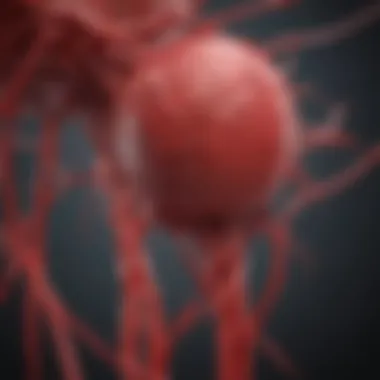
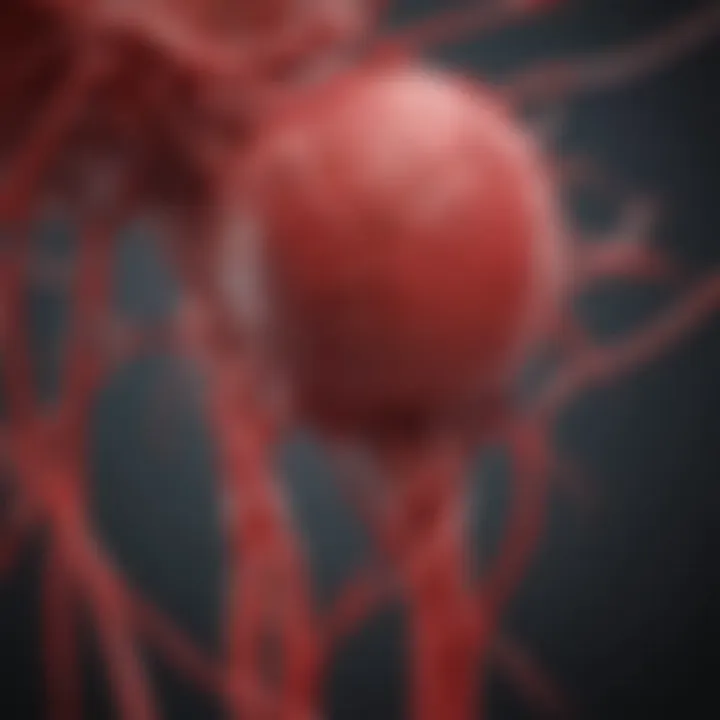
Statistical Evidence of Cancer-Related Thrombosis
Recent studies indicate a strong correlation between blood clots and cancer, emphasizing the need for awareness in healthcare settings.
- Incidence Rate: Research shows that approximately 20-30% of cancer patients will develop a venous thromboembolism (VTE) during their treatment.
- Survival Impact: Venous thromboembolism can negatively affect cancer treatment outcomes, with some studies suggesting that patients who develop clots may have a poorer prognosis.
- Predictive Models: Various studies have resulted in predictive scoring systems designed to identify cancer patients at higher risk for thrombosis. These models aid healthcare providers in decision-making for preventive strategies.
Statistical evidence underscores the critical importance of recognizing thrombosis as a potential cancer marker. Such insights drive the need for interdisciplinary approaches in managing patients at risk.
Types of Cancer Associated with Blood Clots
Understanding the types of cancers associated with blood clots is crucial in recognizing early signs of serious health conditions. This relationship helps medical professionals and patients identify potential risks and adopt critical interventions sooner. Certain cancers have a higher incidence of thrombotic complications due to the biological processes they trigger. Recognizing these connections can foster better patient outcomes and guide future research efforts.
Breast Cancer and Thrombosis
Breast cancer remains one of the most prevalent cancers worldwide. Studies show that women diagnosed with breast cancer face an elevated risk of developing blood clots, particularly deep vein thrombosis (DVT) and pulmonary embolism. This increased risk arises from factors like tumor-induced inflammation and possible complications from therapies such as chemotherapy and hormone therapy. These treatments often involve agents that affect hematological functions, thereby promoting clotting.
A proactive approach to monitoring thrombotic symptoms in breast cancer patients can lead to timely interventions. Patients should be made aware of common signs, such as swelling in one leg and unexplained chest pain. Moreover, healthcare providers should consider the individual risk factors unique to each patient, such as age and family history, when assessing the likelihood of thrombosis.
Lung Cancer and Increased Risk of Clots
Lung cancer is another malignancy with a significant association with blood clot formation. Evidence indicates that up to 30% of patients with lung cancer experience venous thromboembolism (VTE). A variety of biological mechanisms are at play, including the release of pro-coagulant substances by tumor cells. These substances can disrupt normal blood flow and coagulation processes, leading to clots.
Patients diagnosed with lung cancer should undergo regular screening for signs of thrombosis. Symptoms such as shortness of breath and rapid heart rate could suggest an embolism and warrant immediate evaluation. Early detection of blood clots can prove crucial in managing the overall health of lung cancer patients.
Pancreatic Cancer: A Case Study
Pancreatic cancer presents a unique case due to its notoriously late diagnosis and high mortality rate. This cancer is linked to a dramatic increase in thrombotic events, with research indicating that more than half of pancreatic cancer patients may develop VTE. The underlying reasons include hypercoagulability associated with the cancer itself combined with common treatment protocols that can exacerbate the risk of clotting.
The presence of blood clots in patients with pancreatic cancer often complicates treatment plans. For example, anticoagulant therapy must be carefully balanced against the risk of bleeding. Therefore, an awareness of this link between pancreatic cancer and thrombosis is essential for both patients and healthcare providers.
Other Notable Cancers Linked to Thrombosis
Several other malignancies have strong correlations with blood clot formation. These include:
- Colorectal Cancer: Patients often exhibit elevated levels of clotting factors, contributing to increased thrombosis risks.
- Kidney Cancer: The unique physiological alterations induced by kidney tumors can promote clotting.
- Ovarian Cancer: Like breast cancer, ovarian cancer treatments can lead to thromboembolic complications due to hormonal treatments.
In summary, recognizing the types of cancer associated with blood clots underscores the importance of vigilance in patient care. Medical teams should prioritize education about risks and symptom recognition in these populations. Timely diagnosis and intervention can significantly alter the trajectory of care, leading to better health outcomes.
Symptoms of Blood Clots to Watch For
Recognizing the symptoms of blood clots is of utmost importance. Early identification can dramatically influence treatment choices and possibly save lives. Blood clots can lead to serious complications, particularly when linked to cancer. Understanding these symptoms helps patients and healthcare providers to act promptly, improving outcomes and survival rates.
Common Signs of Deep Vein Thrombosis (DVT)
Deep vein thrombosis occurs when a blood clot forms in a deep vein, usually in the legs. Identifying the signs of DVT is essential. Common symptoms include:
- Swelling: Swelling in one leg might indicate clot formation.
- Pain or Tenderness: Discomfort can manifest as pain that starts in the calf or thigh. It may feel like cramping.
- Red or Discolored Skin: The affected area may exhibit unusual coloration, particularly a reddish hue.
- Warmth: The skin over the clot may feel warm to the touch.
"Ignoring these signs can lead to complications like pulmonary embolism, which can be fatal."
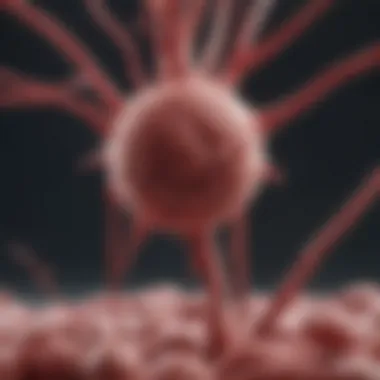
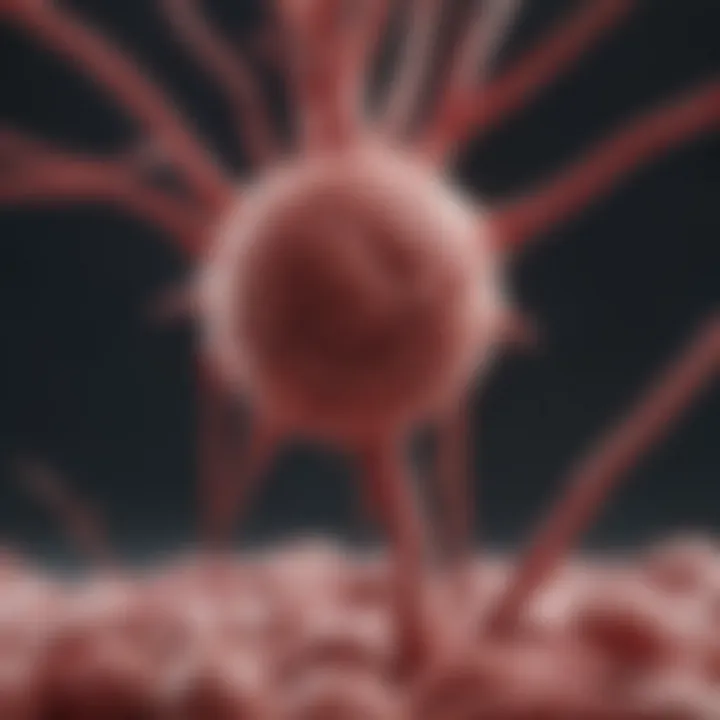
DVT can remain undetected, but timely attention can prevent progression to more severe forms. If symptoms are present, immediate medical evaluation is critical.
Identifying Pulmonary Embolism Symptoms
Pulmonary embolism arises when a clot travels to the lungs, blocking blood flow. This condition poses a serious threat. Symptoms to watch for include:
- Sudden Shortness of Breath: Difficulty breathing that comes on unexpectedly is alarming.
- Chest Pain: Pain may worsen with deep breaths or coughing, causing concern.
- Coughing Up Blood: This is a clear sign that should lead to immediate medical attention.
- Rapid Heart Rate: An increased heart rate can indicate the body is struggling to cope.
- Feeling Lightheaded or Fainting: Severe drops in blood pressure can lead to dizziness or loss of consciousness.
Recognizing these symptoms promptly can be lifesaving. Individuals at risk, especially those with a history of blood clotting disorders or cancer, should pay special attention to these warning signs. Awareness can empower one to seek help when it matters most.
Diagnostic Approaches
Understanding the role of diagnostic approaches in the context of blood clots and cancer is crucial. Early detection of blood clots can provide vital clues about underlying malignancies. Timely diagnosis improves treatment outcomes and may even enhance survival rates. The relationship between thrombosis and cancer is multifaceted, making robust diagnostic methodologies essential. Health professionals must rely on a combination of blood tests and imaging techniques to pinpoint the presence of clots and any associated cancers effectively.
Blood Tests for Thrombosis and Cancer
Blood tests serve as an initial line of defense in detecting the presence of blood clots and their potential connection to cancer. Specific markers can indicate thrombosis. Two commonly used tests include D-dimer and prothrombin fragments. Elevated levels of D-dimer often suggest recent clot formation. This test is sensitive, meaning it can detect most cases but not specify causes. Similarly, prothrombin fragment levels can help determine clotting status, offering further insight into potential underlying conditions.
Apart from these, complete blood counts may give additional information about a patient’s overall health. Abnormalities in platelet counts or variations in white blood cells can hint at possible malignancies. Regular monitoring of these biomarkers can be beneficial, especially for patients known to be at higher risk of cancer-related thrombosis. Incorporating such tests into a routine checkup can lead to earlier interventions.
"Early blood tests can act as crucial indicators that lead to timely cancer diagnosis."
Imaging Techniques to Detect Clots
Imaging techniques play an instrumental role in confirming the presence of blood clots. Various methods help clinicians visualize potential areas of thrombosis. Ultrasound is considered the standard initial diagnostic tool for detecting deep vein thrombosis. This technique uses sound waves to create images of blood vessels, allowing the identification of clots in real-time.
Another method is computed tomography (CT) scans, which are often used when pulmonary embolism is suspected. A CT pulmonary angiogram enables detailed images of blood vessels in the lungs, identifying clots that may not show up in other tests.
Magnetic resonance imaging (MRI) can also be effective, particularly in cases involving brain or spine clots. It provides a clear image without the use of radiation.
Choosing the right imaging tool depends on various factors, including the specific circumstances of the patient and the location of the suspected clot. Each method offers unique benefits, and understanding their limitations is essential for conducting accurate assessments.
The integration of blood tests and imaging techniques provides a comprehensive approach to diagnosing blood clots. This synergy can enable health professionals to detect potential cancers earlier, ultimately improving patient outcomes.
Treatment Options for Blood Clots in Cancer Patients
Blood clots are a significant concern for cancer patients due to the increased risk of thrombosis associated with many malignancies. Treating blood clots effectively is critical not only to prevent severe complications but also to improve overall patient outcomes. When addressing blood clots in the context of cancer, it is crucial to consider the treatment options that can minimize risks and support the patient’s well-being.
Two primary treatment approaches are commonly utilized: anticoagulation therapy and surgical interventions for severe cases. Both strategies play a vital role in managing blood clots specifically in cancer patients, and each comes with its unique considerations.
Anticoagulation Therapy
Anticoagulation therapy is the first-line treatment for blood clots in cancer patients. This involves administering anticoagulant medications that prevent blood from clotting, thereby reducing the risk of further thrombus formation. Some of the most used anticoagulants include heparin and warfarin. Additionally, direct oral anticoagulants like rivaroxaban and apixaban are becoming increasingly popular due to their ease of use and fewer monitoring requirements.
The choice of anticoagulant may depend on various factors, including the patient's specific cancer type, their overall health, and potential drug interactions. Blood tests and regular monitoring are essential to ensure the effectiveness of the therapy and adjust dosages as required. Potential side effects, such as bleeding risks, must also be taken seriously when managing anticoagulation in cancer patients. Therefore, careful assessment and ongoing monitoring by healthcare providers are imperative to balance the benefits and risks of anticoagulation therapy.
Surgical Interventions for Severe Cases
In certain instances, anticoagulation therapy alone may not suffice, especially in severe cases of thrombosis. Surgical interventions become necessary when there is a significant risk of complications or when a large clot impedes blood flow. Procedures such as thrombectomy may be required to physically remove the clot from the blood vessel. However, not all patients are candidates for surgery, and these decisions should be made after thorough evaluation.
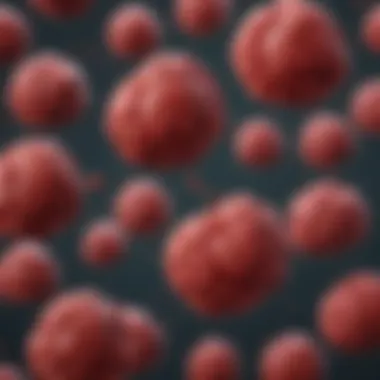
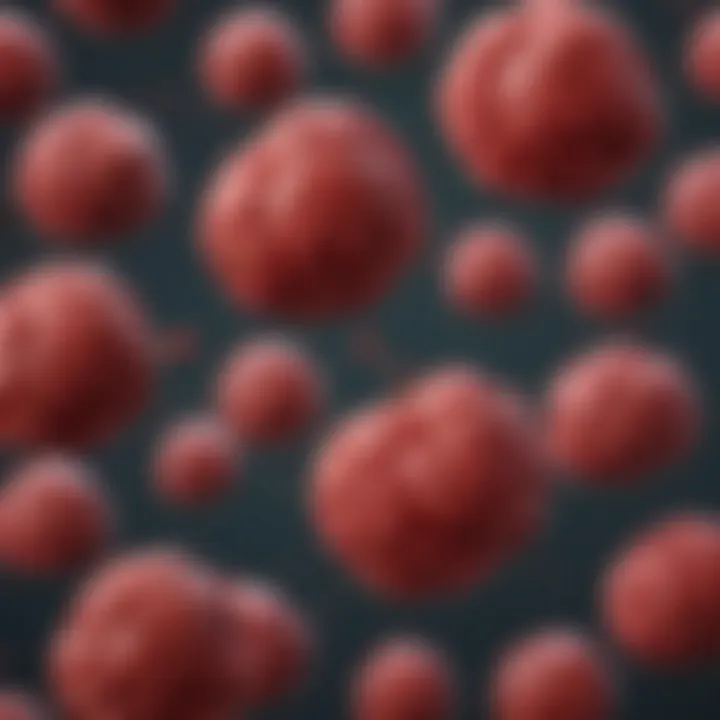
Surgical options are generally reserved for acute scenarios where immediate relief is needed. This might include cases of pulmonary embolism, where a clot has traveled to the lungs, causing severe respiratory distress. Surgical interventions can be lifesaving, but they also come with their own set of risks, including infection and recovery complications. Thus, surgeons must evaluate each patient individually, considering factors such as the extent of the disease and the patient's general condition.
Overall, treating blood clots in cancer patients involves a nuanced approach that considers the unique challenges posed by cancer itself. Ongoing research continues to illuminate best practices and innovative treatment options that could yield even better outcomes for those at risk of thrombotic events.
"Understanding the complexities of blood clot treatment in cancer patients is essential for improving care and optimizing therapeutic strategies."
By delving into these treatment modalities, healthcare professionals can better manage the risks posed by thrombosis in their cancer patients, ultimately aiming to enhance quality of life and survival outcomes.
The Importance of Awareness and Research
Understanding the relationship between blood clots and cancer is critical for patients and healthcare providers alike. Both groups must recognize the potential of blood clots as early warning signs. When patients are informed about the symptoms of blood clots, they can seek medical attention promptly, potentially leading to earlier cancer diagnosis and treatment. On the other hand, healthcare providers need to be aware of the signs of thrombosis in patients suspected of having cancer. This mutual understanding creates a more proactive healthcare environment.
Educating patients about thrombosis symptoms not only empowers them but also contributes to improved outcomes. The quicker a blood clot is identified and managed, the better the chances of reducing associated risks. It is important to understand that blood clots can lead to complications such as deep vein thrombosis, which can advance to pulmonary embolism. This awareness helps patients appreciate their health conditions better and encourages them to engage in discussions with their healthcare providers.
Additionally, research into this pivotal area can yield significant advancements. Ongoing studies about the mechanisms of blood clot formation and its implications in cancer can lead to new treatment protocols. Focusing on thrombosis can facilitate innovations in diagnostic tools as well. These advancements can ensure that blood clot formation is not just seen in isolation, but rather as part of a broader understanding of cancer diagnostics.
"Awareness catalyzes not only patient knowledge but also drives research towards significant medical breakthroughs."
In summary, the importance of awareness regarding blood clots and their potential association with cancer cannot be overstated. Both patients and healthcare providers must work together to identify risks, symptoms, and necessary interventions. As research continues to evolve in this area, the overall understanding and management of cancer linked to thrombosis can improve significantly, paving the way for better patient care and outcomes.
Educating Patients and Healthcare Providers
One of the foundations for improving patient outcomes lies in effective education. Patients need to know the signs of blood clots, which can include swelling, redness, and pain usually in one leg. They must understand that these symptoms can indicate more serious conditions. When patients are informed, they are more likely to report unusual symptoms to their doctors promptly.
Healthcare providers also play a significant role in education. Training on the correlation between blood clots and different types of cancer should be a part of their continual professional development. When providers can recognize the signs, they can act swiftly. They can not only educate their patients but also ensure that protocols are followed for observation and testing.
Strategies to enhance education could include:
- Workshops on recognizing thrombosis symptoms and cancer risks.
- Informational materials, such as brochures or online resources.
- Discussion forums where patients can share experiences and learn from each other.
Fostering an environment of clear communication reduces the chances of misdiagnosis or late diagnosis.
Advancements in Cancer Research Focused on Thrombosis
Research plays a crucial role in understanding the complex relationship between blood clots and cancer. Recent studies have indicated that certain cancer types significantly increase the risk for thrombosis. For instance, research focusing on breast cancer has unveiled mechanisms that promote clot formation, helping clinicians develop targeted interventions.
Moreover, advancements in biotechnology have permitted the development of new blood tests that can help in early detection of clotting disorders related to cancer. These tests aid in identifying patients at risk and allow for timely management strategies. The goal of this research is to translate complex findings into practical solutions for healthcare.
Furthermore, collaborative efforts among research institutions, universities, and pharmaceutical companies can yield breakthroughs in understanding the relationship between cancer and thrombosis. Clinical trials that explore innovative treatment options—like targeted therapies or new anticoagulants—also shed light on this intersection.
Culmination
In summary, the relationship between blood clots and cancer is multifaceted and significant. Identifying blood clots as potential early indicators of malignancy can guide healthcare providers in diagnosing underlying health issues more proactively. Understanding the biological mechanisms that connect these two phenomena enhances our ability to intervene earlier, potentially improving patient outcomes.
Summarizing Key Points
- Blood clots often serve as early warning signals for various cancers, including breast, lung, and pancreatic cancer.
- Thrombosis can be driven by cancer's biological behavior, which alters normal blood coagulation processes.
- Recognizing symptoms associated with blood clots, such as those indicative of deep vein thrombosis or pulmonary embolism, empowers patients and providers alike.
- Advances in diagnostic approaches, including blood tests and imaging techniques, are crucial for timely detection of both thrombosis and underlying cancers.
Future Directions in Research and Treatment
Research efforts should focus on several key areas to further elucidate this connection:
- Investigating Biomarkers: Identifying specific biomarkers associated with both blood clot formation and different cancer types could aid in early detection strategies.
- Risk Factor Studies: Understanding environmental and genetic predispositions to thrombosis in cancer patients will improve preventive measures.
- Innovative Treatment Protocols: Development of tailored anticoagulation therapies specific to cancer types may minimize complication risks while maximizing patient safety.
As research continues, the intersection of oncology and hematology presents an opportunity to refine strategies for early detection and improve patient care in a holistic manner.



